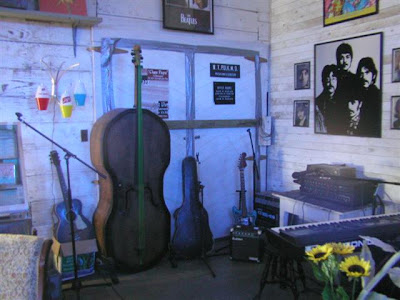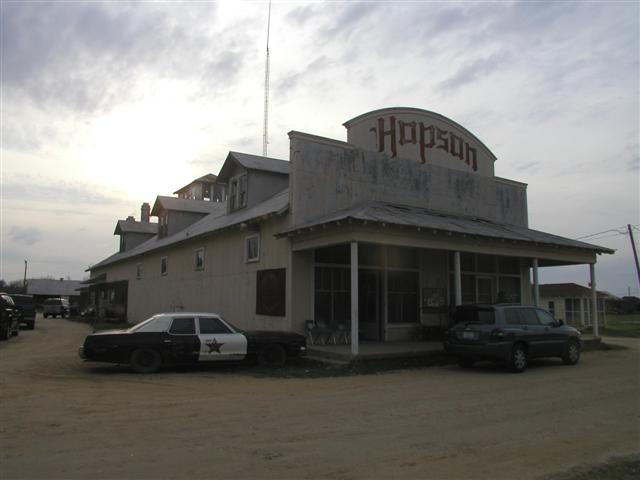Photos by Elodie Pritchartt
The transformative power of a music genre, and the road that leads to it.
Quick, think of a small delta town, hot as hell in the summer and within walking distance of cotton fields with juke joints, river traffic, gambling, drinking, dancing—a place where the music of its poor became the music of the world. If that sounds like Clarksdale, home of the blues in the Mississippi Delta, it also describes Ferriday in southeast Louisiana.
Like Clarksdale, Ferriday is not a very big place, just about four thousand people. Like Clarksdale, Ferriday is a river town, full of fun-loving characters—a few who like to take a walk on the wild side; the birthplace of entertainers Jerry Lee Lewis, Mickey Gilley, and evangelist, Jimmy Swaggart. Like Clarksdale, Mississippi; Ferriday, Louisiana had a whole lotta shakin’ goin’ on.
No wonder, my friend Tommy Polk, decided to start our tour of Highway 61 at the Delta Music Museum in Ferriday. Rosemary, a petite African-American lady, greeted us inside the museum and led us through a maze of displays of cousins Lewis, Gilley and Swaggart and memorabilia from dozens of other area musicians. She told of the infamous juke joint, Haney’s Big House and trombonist, Leon “Pee Wee” Whittaker.
“He used to hold Jerry Lee up to the window so that he could see the performers like Fats Domino at Haney’s—and they had a thing worked out where Pee Wee would leave the back door open there for little Jerry Lee.”
That, as legend has it, was where “The Killer” developed his taste for boogie woogie and rhythm and blues. Throughout the rest of the tour, Rosemary gave sordid and lofty details of various artists’ lives like a gossipy but loving auntie, once again proving that the best guides are true locals.
 On a Jerry Lee kick, we rushed around the block to see another tribute to The Killer, the Lewis Family Museum. Forewarned with words like bizarre, freaky, surreal, too real, I thought I was prepared. But nothing could have prepared me for the mind of Frankie Jean, Jerry Lee’s sister. I say the mind, because the museum is her temple to her family—a packrat’s unapologetic display of the family’s demons and accomplishments with a disturbed sense of décor.
On a Jerry Lee kick, we rushed around the block to see another tribute to The Killer, the Lewis Family Museum. Forewarned with words like bizarre, freaky, surreal, too real, I thought I was prepared. But nothing could have prepared me for the mind of Frankie Jean, Jerry Lee’s sister. I say the mind, because the museum is her temple to her family—a packrat’s unapologetic display of the family’s demons and accomplishments with a disturbed sense of décor.Utilizing every surface for expression or collection, there are broken-mirror abstracts on doors, Chagall-like paintings of graves and ghosts on the kitchen carpet and bedroom lamp shades, a long brick planter stuffed with Easter grass and badly painted oil lanterns, a collection of whiskey bottles on the piano, a shellacked loaf of bread on the kitchen counter. It is both painful and hilarious. It is a must see. After the tour, you might find yourself hankering for a drink—unfortunately the drive-through liquor store attached to the house was closed.
Still reeling from Graceland-Gone-Twilight Zone, Tommy; his sweetheart Elodie, a poet and photographer; and I stopped at a fast-food restaurant before leaving the Louisiana Delta for the Mississippi Delta. My traveling companions swing easily in my life from old high-school friends to professional colleagues, and without revealing too much of our shared histories, I knew I was in for a good time. Writers all, we settled in for a three-hour ride and an opportunity for uninterrupted storytelling.
About the time we crested the bridge over the Yazoo River, the entrance into the Mississippi Delta, Elodie and I decided it was Tommy’s turn to talk. He told of the day when he was just a boy and he accompanied his father, the Parish coroner, to a shack on the edge of the levee road in Vidalia, Louisiana. They climbed the weathered front steps, crossed the porch, and entered a small dark room where an old man lay dying as his family crowded around him.
The stifling death scene drove Tommy back out onto the porch. Facing the road, he exhaled, listened to the undulating hum of insects match his own steady breathing, and waited for his father’s voice, an official pronouncement of the dying man’s last breath.
“Out of the shack came a long wail,” he recalled.
As he stood there looking down the front porch steps, a couple of neighbors stopped in front of the house.
“They both let out wails. Then more people gathered and they all started this wailing—mourning the old man.”
Like the call and response of a church service the wails from inside led the wails outside.
“It was like they were all looking up at me and wailing,” he explained. “I was frightened, until gradually, the wailing turned to singing. Then they were swaying and I could hear harmony, then they’d start wailing again, and then it would become singing again.”
That, award-winning songwriter Tommy Polk says, was his first real music moment, a heartfelt eyewitness account of how music transforms and transcends.
Tommy grew up a few minutes’ ride from that levee and from Ferriday. Poor eyes but excellent ears, led him to pursue the guitar instead of sports. Later, he found that a song garnered as much attention from girls as a touchdown. With both deep and shallow reasons for loving music, Tommy took his talent for guitar, piano and poetry to Nashville and during a long climb to the top has won ASCAP and BMI citations for chart-topping, internationally popular songs recorded by artists such as Martina McBride, Crystal Gayle, Irma Thomas and many others.
In the midst of Nashville success, Tommy yearned for a retreat where he could hear himself think.
Soon other shacks were added, a commissary became a nightclub/dayclub/jam-session venue and a new style of overnight accommodation that puts the “fun” in funky was born. Nowadays, you’ll find similarly funky guesthouses throughout the Mississippi Delta.
“Look, a dust devil.”
“No, don’t stop and take a picture.”
“Look at that barn.”
“Girlfriend, I said no more pictures.”
“Look, I love that old house.”
“You can take a picture on the way back.”
The miles slid by and then we were in Leland, Mississippi; population about five thousand, which bears a striking resemblance to, you guessed it, Ferriday.
“We’re here to visit Eric Fowler at his brand-new recording studio, Studio 61,” says Tommy, as we park in front of a row of downtown stores. If you’re thinking, “What’s to see, three padded walls and a big pane of glass,” think again.
“The thing we’re most proud of is our live-venue recording abilities—five cameras can capture a live performance either in the studio or in front of a live audience in the studio.”
That explains the room large enough for an audience behind the console. A quick Coke in a nearby coffeeshop and we were on that flat stretch of asphalt again.
Next stop: The Delta Music Institute at Delta State University in Cleveland, Mississippi.
“Oh my God!” Tommy yelled—an octave higher than usual, as we entered the multimillion dollar facility. “I want to go back to college!” he screamed as we entered the gymnasium-size recording studio on the same par as the famed Abbey Road in London.
A tour by the executive director of the program, Grammy Award-winning songwriter Tricia Walker and world-class bass player Barry Bays, confirmed that we all three wanted to go back to college. For anyone with any interest in music, DMI is a fascinating place to visit. For someone with a kid interested in the musical arts or music business, this is the place to send them.
A quick beer and tour of the Cadillac shack and the shack complex now known as the Shack-Up Inn, reveals that Clarksdale knows how to make the most of its funky blues-based tourism. Tommy was instrumental in the development of the concept and with characteristic creative energy has moved on to open three new guesthouses. Two are smack dab in the middle of downtown Clarksdale—Big Pink and Mississippi Music Hall. Honey Hill is quiet, elegant retreat on the Sunflower River.
Big Pink and Mississippi Music Hall are conveniently across the street from the Delta Blues Museum and the main music stage used for blues festivals. Big Pink, an ice-cream parlor turned New Orleans-style townhouse (by ambitious owners in 1960s) is the pretty side of funk, with large guestrooms, a graceful downstairs foyer, dining room, parlor, and a fake indoor courtyard in the back (the courtyard alone is worth the drive to Clarksdale).
Mississippi Music Hall is a turn-of-the-century plantation commissary that Tommy moved in and placed next to Big Pink. A central room with blue windowpanes, comfy stuffed chairs, old rugs and a big screen offers guests a retreat and gathering place during music festivals. The hall also has two guestrooms, one of which we settled into, before walking across the street to Ground Zero blues club for an evening of cold beer and a killer jam session. Believe it or not we behaved ourselves well enough to rise early the next morning and explore Clarksdale.
It looks to me as if Clarksdale has become a Mecca for transplants who have tossed aside conventional lives for unique businesses either based on the blues or because of their love for the blues. A young man from New Jersey owns Cat Head Delta Blues and Folk Art; a retired trust lawyer from The Netherlands opened the Rock’n Roll Blues Heritage Museum, showcasing his vast collection of music memorabilia from the twenties through the seventies; a musician and painter from Florida opened Hambone Art Gallery where you can buy a painting as well as a ham sandwich, and an outdoorsman and artist from Colorado makes artful dugout canoes, paints watercolors and leads canoeing and kayaking expeditions from Cairo, Illinois, to the Gulf of Mexico—to name a few. And the renovation and migration continues. A day in Clarksdale will make you wish that you could spend a month there—or maybe the rest of your life.
After too short a time, we headed for Indianola, Mississippi to the B. B. King Museum, the polar opposite of the Lewis Family Museum. State-of-the-art exhibits housed in a gorgeous facility stimulate visitors through a totally interactive environment. It is a fitting tribute to the legend of guitar blues, and a shining example of modern museums. Elodie and I particularly enjoyed the digital guitars that allow you to play like B.B.—or at least feel like you are.
Exhausted from our whirlwind tour of Highway 61, we buckle up for the drive home. I ask Tommy what’s next on his agenda.
“I want to bring music back to Ferriday, and I’d love to see Ferriday become the next Clarksdale. I’d also like to take people on music and heritage tours from Nashville to New Orleans.”
It’s one shack. The beginning.



























Good evening
ReplyDeleteAwesome post, just want to say thanks for the share
Hi, very interesting post, greetings from Greece!
ReplyDelete